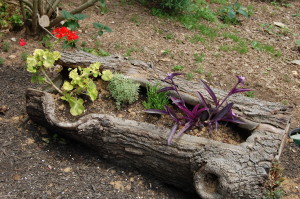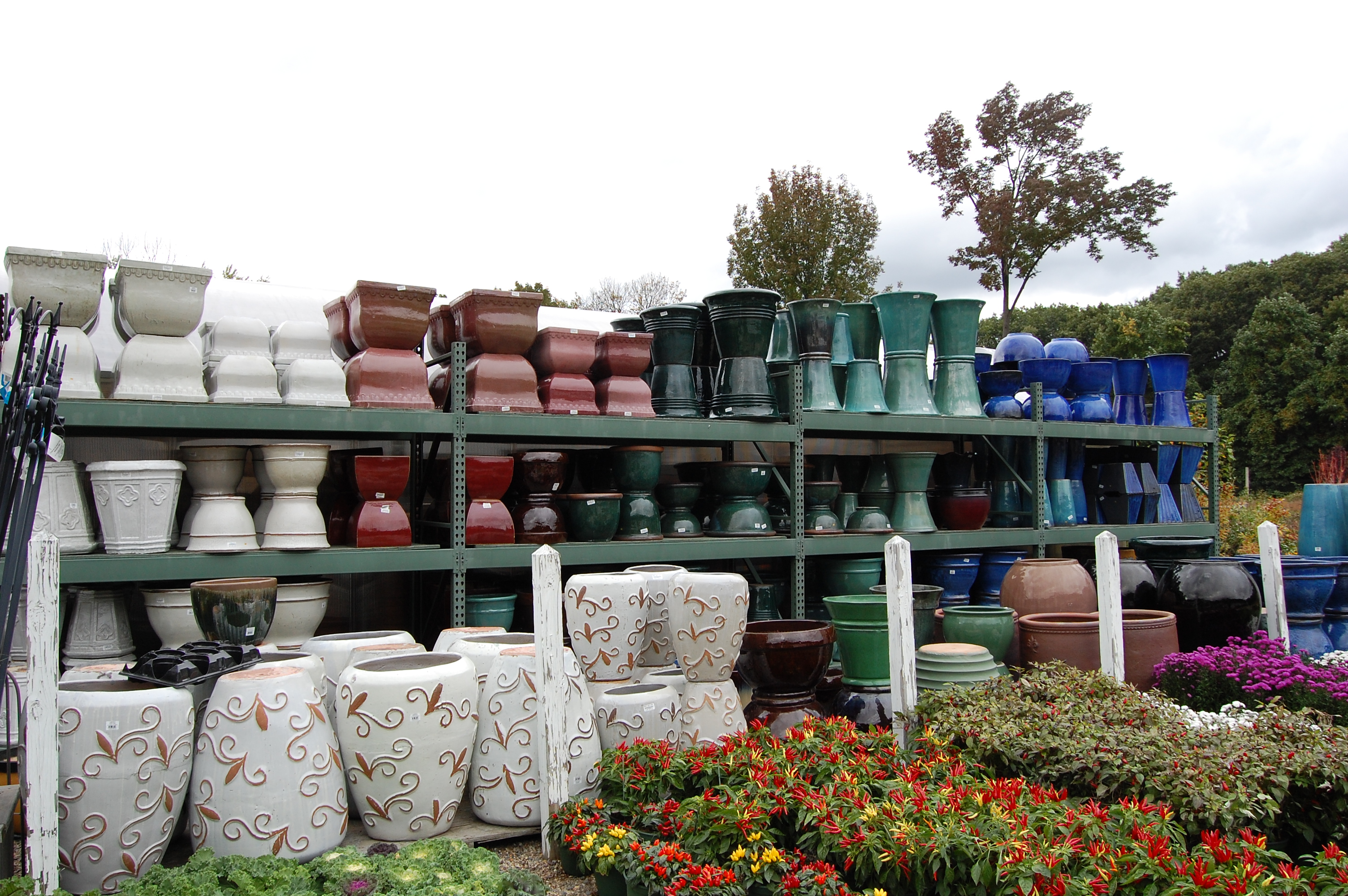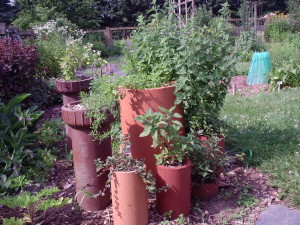What do you do if there is no room in your vegetable garden for herbs and you don’t have space for a separate herb garden? What if you only want to grow a few herbs? What if your “backyard” consists of a deck or balcony? What do you do if you want to grow your herbs right outside your kitchen door instead of having walk out to a garden bed? The answer to all of these questions is the same: grow your herbs in a container.
Choosing a Container
Herbs can be grown in different types of containers. Your main consideration is size. The container should be at least wide enough for the herb and deep enough for its rootball. Most herb containers are 15 to 120 quarts in capacity, depending on the size of the plants and how many you plan to put into them. You can use almost anything to grow herbs in. Plastic, clay or ceramic pots, half barrels or other wooden containers. If you use wood, make sure that it hasn’t been treated with penta (pentachlorophenol) or creosote both of which are toxic to plants. Repurposed items such as plastic milk jugs make excellent containers. I’ve even seen old pieces of pipe used for herb containers.

Hollowed out log used as a container
Another consideration is weight. Clay or ceramic pots are heavy when filled with soil and even heavier right after watering. If you must move your container around your deck or balcony to catch the sun, use a plastic container or consider getting a small wheeled dolly.
No matter which container you choose, make sure that it has a drainage hole or holes. It’s a good idea to raise your container off the ground with bricks or cement blocks for best drainage. Herbs do not like wet feet.
Soil is Important
Because your container is outside, many people think that you can fill it with ordinary garden soil. This is not recommended. Garden soil is full of insect eggs and weed seeds that could germinate and crowd out your herbs. It harbors mold and fungi spores or disease that could injure or kill your herbs. You can make your own potting soil using compost plus sand or peat moss (for drainage). The best potting soil to use can be purchased from your local nursery. It’s sterile, meaning it isn’t full of insect eggs and weed seeds, light enough to drain properly and some even come with slow-release fertilizer. I have seen recommendations that gardeners use soilless potting mixes. The only problem with using a soilless mix is that it contains no nutrients so you must fertilize frequently.
If you are growing annual herbs in a large container, at the end of the season when the herbs die or are discarded, there is the temptation to reuse the soil the following year. This is not a good practice. The soil has been collecting weed seeds, insect eggs, mold and fungi spores or disease all summer that could harm your plants next year. It should be thrown out. Some people spread used potting soil in their garden beds mistakenly believing that they are “improving” their garden soil. In reality, they are just spreading weed seeds, insect eggs, mold and fungi spores all over their garden. Discarding soil feels like a waste, so I compromise. I throw my old potting soil in my composter. This allows the microbes in my composter to clean up the soil and the other “ingredients” in my composter add nutrients.
Obviously, if you are growing perennial herbs such as rosemary in containers then you can’t discard the soil. You have two options. You can remove the plant from the container and discard any loose potting soil and replace it with new potting soil. The drawback to this is that you are disturbing the plant’s roots which will cause it to go into transplant shock from which it may or may not recover. The best way to “renew” the potting soil in a container planted with perennial herbs is to carefully remove the top two inches of soil and discard it. Most of the weeds seeds, insect eggs, mold and fungi spores are in the top two inches of soil. Once you have discarded the old potting soil, you can replace it with new potting soil.
The Right Mix of Plants
Most gardeners like to use larger containers, growing more than one kind of herb in them. Make sure that the herbs that you plant together all have the same growing requirements. Don’t plant shade lovers with sun lovers. Don’t plant herbs that like it dry, such as rosemary and lavender, with herbs that need a lot of water like basil. You can grow annual and perennial herbs in the same pot, provided you remove the dead or dying annuals in the fall. Leaving dead plant material in your container provides a perfect environment for mold and fungi spores as well as hibernating insects in the winter. When the soil warms in the spring, the spores will grow and the insects awaken and severely damage or kill the perennial herbs growing there.
Mints must be planted by themselves in containers. They are aggressive growers, crowding out the plants around it. Just for fun, I planted three different types of mint (spearmint, peppermint and chocolate mint) in one container just to see what would happen. The foliage covered the battle zone until winter so I didn’t see the results for months. It was a tie. All three mints retreated to the edges of the pot, leaving the center, or battleground, bare.
You may want to plant an herb in a pot so that you can bring it in during the winter. Although bred to be hardy to zone 6, rosemary often times doesn’t survive a harsh winters in colder zones so gardeners bring them indoors in the fall. Spanish lavenders are only hardy through zone 7 so you would want to grow them in a container in colder zones so that you can bring them into the house when the weather turns cold. Bay laurel, hardy in zones 8-10, is another herb that will make the trek every year from your house to your garden and back again. It is a tree, so you will have to severely prune it to maintain it in a pot.
Water, water, water
Many customers have complained to me that their herbs died within a few weeks even though I had assured them that they could be grown in containers. When I ask how often they watered their containers, I usually get one of two answers: “never, we got a lot of rain last year” or “once a week”. Containers dry out faster than your garden. It makes sense if you think about the volume of soil. How much soil is in your garden versus how much soil is in your container? Of course, the container with the smaller amount of soil will dry out more quickly. Containers should be watered often, sometimes every day. In very hot weather when plants become stressed from the heat, I water my containers twice a day to keep the soil cool.
An exception to the daily watering rule are drought tolerant herbs such as rosemary, lavender, sage, thyme and bay laurel. These herbs prefer dry conditions. You should only water them when the soil in the container dries out. You might be able to get away with weekly rather than daily watering.
Fertilizer
Normally I advise lightly fertilizing herbs. Grown in containers, herbs need more fertilizer than when they are grown in the ground. This is because every time you water your containers, you are washing nutrients out of the soil. Over the course of a growing season, the potting soil could become sterile with no nutrients in it and your plants could starve.
The easiest fertilizer for containers is slow-release fertilizer. This is fertilizer that has been pelletized and each pellet coated with polymers that dissolve at different rates and release the fertilizer into the soil at a steady rate over the growing season. It comes in 60 day or 120 day versions. Most potting soils now come with 120 day slow-release fertilizer already in it so you don’t have to think about fertilizing your plants during the summer growing season.
Another option is to use water soluble fertilizers every two weeks over the growing season. Read the directions on the label carefully for the correct dilution. You never want to apply these types of fertilizer at full strength to your containerized plants. It will kill them.
For perennials that will stay in their containers past the outdoor growing season, you can use a combination of fertilizers. Over the growing season, you can use slow-release fertilizer and then switch to water soluble fertilizer in the fall after the outdoor growing season, none in the winter so that the plants can go dormant or rest and then resume fertilizing with either water-soluble fertilizer or slow-release fertilizer in the spring when your herbs begin growing again.



4 Comments on “Growing Herbs in Containers”
Hi, I grew Lavender & rosemary together last year and it looks like both are dead. I am not sure of the lavender. But I could plant Lavender, Rosemary, Sage, Thyme & bay laurel together?
I have quite large pots and would love to plant a whole bunch together. Could I plant Parsley, Savory, Lemon Grass,Basil together? Also some flowers? I am very green at this and need lots of direction.
You might laugh but I planted Mint in a pot by itself last year and I killed it. I think I over watered it. I will try again this year. Please help.
Arlene, the herbs you mentioned get quite large and should be grown in individual containers. For instance, bay laurel is a tree! Lavender, rosemary and sage are all woody shrubs. When you are planning your containers, you should look at how large each plant will become. You can’t go by how large the plants are when you buy them. They are only seedlings now. Lemon grass will become a large clump of grass, 2 feet tall and 2 feet wide. Basil, depending on the variety, will grow to 18″ to 24″ tall and 12″ to 18″ wide.
You should really only grow one or two herbs per container. Don’t crowd them. If you plant too many in a container, they won’t grow to full size. They will be small, weak and prone to disease. They will also become infested with insects because they love to nest in crowded plants. A crowded container may look great on Pinterest, but it is unhealthy for the plants.
You were correct to plant your mint in a separate container. It died because it either didn’t get enough sun or it didn’t get enough water.
Just found your site and I am impressed with your knowledge and carefully worded replies and advice.
We live in central Virginia and I am getting ready to plant two or three different varieties of rosemary (2-3 plants) in the middle of a variety of 4 or 5 lavender plants in a partly strong sun, partly shade area. I am planning to plant them altogether about 12 to 18-inches apart, maybe with the Rosemary plants in a 24″ diameter triangle at the center of the bed with a surrounding loop of the lavender. Location is pretty dry but somewhat ckay and rocky. The planting area selected is in a well-drained area that we do not usually water too much… currently growing there nearby is a tall tree, some Irises, some daffodils and some kind of Ferny bush, all of which are very healthy in my opinion. If I get the spacing or the soil or the sun exposure wrong, what is my risk?
-all plants die?
-some die and some flourish?
I think I’ll give it a shot. Is my plan okay?
Thanks for your consideration. I am new at this.
Steve
There are two issues here which will affect both your lavender and your rosemary. The first one is sunlight. Both lavender and rosemary need full sun, a minimum of 6 to 8 hours daily. Neither will grow well in partial shade. The bigger issue is space. You are not allowing enough space for all of your plants. Both lavender and rosemary are woody shrubs. I don’t know what kind of lavender you have, but the largest ones get to 3 feet tall and 3 feet around. The rosemary will grow even larger, between 3 and 6 feet tall and around, depending on the variety. The space that you have allocated for 6 to 8 plants is only sufficient for 1 to 2 plants.